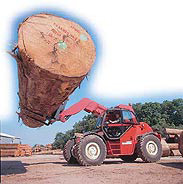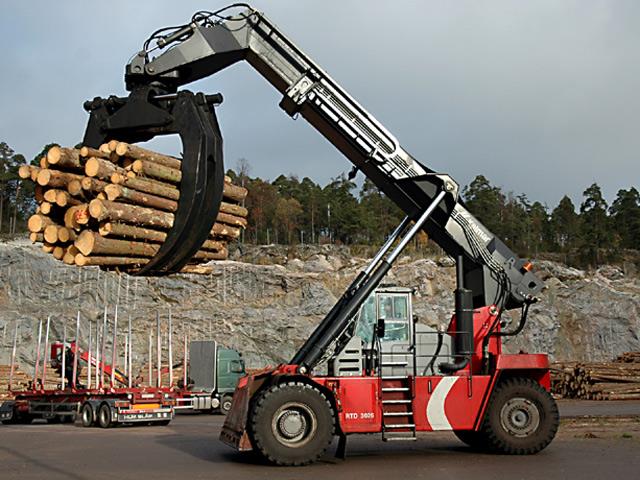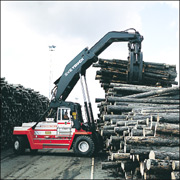 The Manitou MHT 7140 telehandler. |
By
Christine LiewThe Swedish Forestry Industries Federation asked forest industry consultants Jaako Pöyry to calculate how important the industry was to Sweden and the results were startling. The research found the Swedish forest industry's exports totalled 110 billion kroner (USD13.9 billion) in 1996, enough to pay for all Sweden's imports of oil, food, clothing and cars.
The federation says Nordic European countries are the world's largest net exporters of paper and among the world's top net exporters of pulp. Sweden is the world's fifth largest paper producer and the fourth largest exporter of pulp, after Canada, the USA and Brazil. The top paper producers are the USA, China, Japan, Canada and Germany and the world's leading sawn timber and softwood producers are the USA, Canada, Russia, Germany and Sweden. In 2004, the world produced about 188 million tonnes of pulp, 360 million tonnes of paper and 311 million cubic metres of sawn timber and softwood.
With 3.9 billion hectares of forest in the world, the machines that fell, yard, process and load trees and logs are important to keep the industry moving. Major forest product companies, like Weyerhaeuser, International Paper, Stora Enso, UPM and Canfor, are only a few examples of end users that rely on forestry equipment.
Forestry EquipmentWhen trees are logged and harvested, forklifts rarely play a role. It is only during loading and milling operations that forklifts can be used. Forestry equipment like feller-bunchers cut trees and make bunches of them. Grapple skidders grab bunches of logs and transport them to landings where they are delimbed and cut to length by log processors or chainsaws. Processed logs are loaded onto trucks and sent to destinations like sawmills, pulp and paper mills and chipboard mills.
The first stage in which a forklift is used is when harvested logs are loaded onto trucks. Other equipment commonly used includes harvesters with arms and grapples, excavators with clamps, wheel loaders with clamps, and telescopic forklifts. Manitou product manager Philippe Richard, whose company started selling equipment to the logging and timber industry in the 1960s, said he had never seen a rough-terrain masted forklift used at a loading point. "The masted forklift can't offset the load in front of the wheel," he said. Richard has spent eight years at a Manitou Singapore subsidiary prospecting south-east Asian markets that include the timber industry. The Asian and African markets constitute 80 per cent of Manitou's sales in the timber industry.
Once trucks are loaded, they go to a mill's entrance, the logyard, and logs are unloaded. While waiting to be fed into the mill for processing, logs are stacked four to five metres high and stored at the yard. At this stage, equipment used to load the trucks can be used to unload them. Other equipment that can do the job includes overhead cranes and reach stackers fitted with grapples, called log stackers.
Log stackers were common in Nordic European countries, Richard said.
"There are many brands of log stackers but the main ones are Kalmar and Timberjack (a John Deere-owned brand). Log stackers can be used as long as the ground they operate on is solid.
"The log stacker's advantage is it can take 15 tonnes to 30 tonnes in one shot. Its clamp can take the full contents of a truck, just like overhead cranes. However, its rough-terrain performance is very poor. It has very low ground clearance and, because it can take such a heavy load, it works on concrete floors," Richard said. Manitou masted rough-terrain forklifts have load capacities up to 7.5 tonnes while telehandlers like the MHT 10160L can carry up to 16 tonnes.
Southern hemisphere regions, like Africa, South Asia, Indonesia and Papua New Guinea, have unpaved logyards due to the high cost of paving surfaces. It was common for those regions to unload and stack logs using telescopic and rough-terrain masted forklifts, Richard said.
 The Kalmar RTD3026 log stacker. |
Pasi Rantanen, Kalmar vice president for log stackers, told Forkliftaction.com News the size of the wood handling market was about 400 machines annually. Svetruck is Kalmar's main competitor and both Swedish manufacturers sell 40 to 50 log stackers a year.
Rantanen agreed with Richard that log stackers were not designed to work on non-paved surfaces. Kalmar has been building log stackers since the 1970s. They are purpose-built machines with telescopic booms and hanging grapples that swing sideways and lengthways. Manitou telehandlers can be fitted with rotating grapples but the main differences between the telehandler and the log stacker is the telehandler's rough-terrain ability and lower load capacity. Rantanen said he had never seen a machines like the Manitou MVT 675T telehandler used for loading trunks in Scandinavia and Europe.
He said wheel-loader based log stackers or wheel-loaders with grapples were a very popular equipment choice among forest product companies.
"Volvo is one of the leading manufacturers. It has a market share of 100 to 200 machines a year. However, our log stackers have a bigger capacity than the wheel-loader based log stackers and our transportation features are better, meaning the machines move around more smoothly as they're designed to handle logs. The wheel-loader is basically a wheel-loader with its bucket removed and a log handling system installed."
The Volvo Group's forestry equipment is part of the Volvo Construction Equipment business segment. The group's website said Volvo was a leading global forestry equipment manufacturer for two decades (1960s to 1970s), with forestry equipment constituting a large part of its turnover. However, a decision to focus on the construction equipment sector led to the divestment of its forestry equipment operations in 1977.
Generally, log stacker manufacturers make their own attachments, log clamps or grapples. "It comes from history; we have always done grapples ourselves. It's meeting customers' requirements for grapples that come in different shapes and sizes," Ratanen said.
 A Svetruck TMF 15/11 log stacker. |
"The main thing in log stackers is that you get a full grapple all the time. The grapple must be full of logs. This does not happen when customers fail to supply clear information about the size, length of log, and whether they are unloading from trucks or railcars and how much they want to get in one pick."
Kalmar does not sell log stackers to the USA because of different wood harvesting techniques.
"We sold a few machines a few years ago to a US company that was handling small trees but the wood was still too long for our machines. Our log stackers are designed to handle cut-to-length wood. In Scandinavia and Europe we get more efficiency by cutting the wood in the forest to suitable lengths. Our grapples could not safely handle the wood length for the US industry, which could be from 20 metres to 60 metres. The Scandinavian technique involves cutting logs five to seven metres long."
(Note: Forkliftaction.com News could not contact a US log stacker manufacturer before publication time. Do US manufacturers use excavators more instead of log stackers? Discuss this at the
forums.)
Purchasing CriteriaOne criterion customers have when buying forestry equipment is that the machinery does not damage the forest floor. While damage to timber occasionally happens, pressure is constantly exerted on the ground when forestry equipment is moving about felling and processing tree trunks.
Manitou's Richard said countries in the northern hemisphere tended to follow European environmental directives strictly.
"For forklifts, we try to make the machines not so heavy. If it's meant to carry four tonnes then we design it as such. We also have wide tyres to spread the weight across a bigger surface. Some dedicated harvesters use tracks instead of wheels but, of course, we don't have that with forklifts. We try our best to limit the ground pressure."
But forklift manufacturers do not have to focus much on protecting forest floors as nearly all forklifts are used during indoor milling operations.
Damage to logs is a concern as logs, especially hardwood logs, are expensive. Damage generally occurred with forklifts fitted with forks. If the logs are not steady on the forks, they can roll and fall onto the ground. Clamps are better suited to carry logs and large corporations in the timber industry use them. Smaller operations sometimes used forks, Richard said.
Pasi Ratanen said Kalmar customers often compared Kalmar machines with competitors' machines."Price is important to them," he said, adding that log stackers were not cheap.
Richard agreed: "The timber industry is very particular about the owning and operating cost of a machine versus its production output. They calculate how much a forklift costs them per cubic metre of wood it handles."
So cost is central and, after that, customers in the logging and timber industry consider criteria like ground damage and accessibility to harvesting sites.